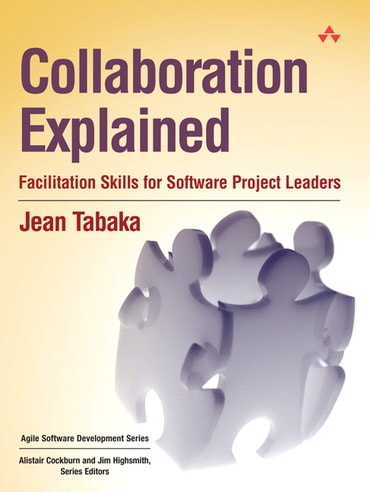
Collaboration Explained: Facilitation Skills for Software Project Leaders, 1st edition
Published by Addison-Wesley Professional (January 6, 2006) © 2006
- Jean Tabaka
Price Reduced From: $59.99
Details
- A print text
- Free shipping
- Also available for purchase as an ebook from all major ebook resellers, including InformIT.com
“Collaboration Explained is a deeply pragmatic book that helps agile practitioners understand and manage complex organizational and team dynamics. As an agile coach, I’ve found the combination of straightforward advice and colorful anecdotes to be invaluable in guiding and focusing interactions with my teams. Jean’s wealth of experience is conveyed in a carefully struck balance of reference guides and prose, facilitating just-in-time learning in the agile spirit. All in all, a superb resource for building stronger teams that’s fit for agile veterans and neophytes alike.”
—Arlen Bankston, Lean Agile Practice Manager, CC Pace
“If Agile is the new ‘what,’ then surely Collaboration is the new ‘how.’ There are many things I really like about Jean’s new book. Right at the top of the list is that I don’t have to make lists of ideas for collaboration and facilitation anymore. Jean has it all. Not only does she have those great ideas for meetings, retrospectives, and team decision-making that I need to remember, but the startling new and thought-provoking ideas are there too. And the stories, the stories, the stories! The best way to transfer wisdom. Thanks, Jean!”
—Linda Rising, Independent Consultant
The Hands-On Guide to Effective Collaboration in Agile Projects
To succeed, an agile project demands outstanding collaboration among all its stakeholders. But great collaboration doesn’t happen by itself; it must be carefully planned and facilitated throughout the entire project lifecycle. Collaboration Explained is the first book to bring together proven, start-to-finish techniques for ensuring effective collaboration in any agile software project.
Since the early days of the agile movement, Jean Tabaka has been studying and promoting collaboration in agile environments. Drawing on her unsurpassed experience, she offers clear guidelines and easy-to-use collaboration templates for every significant project event: from iteration and release planning, through project chartering, all the way through post-project retrospectives.
Tabaka’s hands-on techniques are applicable to every leading agile methodology, from Extreme Programming and Scrum to Crystal Clear. Above all, they are practical: grounded in a powerful understanding of the technical, business, and human challenges you face as a project manager or development team member.
· Build collaborative software development cultures, leaders, and teams
· Prepare yourself to collaborate—and prepare your team
· Define clear roles for each participant in promoting collaboration
· Set your collaborative agenda
· Master tools for organizing collaboration more efficiently
· Run effective collaborative meetings—including brainstorming sessions
· Promote better small-group and pair-programming collaboration
· Get better information, and use it to make better decisions
· Use non-abusive conflict to drive positive outcomes
· Collaborate to estimate projects and schedules more accurately
· Strengthen collaboration across distributed, virtual teams
· Extend collaboration from individual projects to the entire development organization
Need help? Get in touch
 A print text
A print text